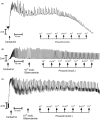Quercetin relaxes human gastric smooth muscles directly through ATP-sensitive potassium channels and not depending on the nitric oxide pathway
- PMID: 33528064
- PMCID: PMC8365708
- DOI: 10.1111/nmo.14093
Quercetin relaxes human gastric smooth muscles directly through ATP-sensitive potassium channels and not depending on the nitric oxide pathway
Abstract
Background: Quercetin has recently become a remarkably popular subject of research due to its broad beneficial pharmacological properties. The goal of our study was to observe its effects on contractility of human gastric smooth muscles in reference to the NO pathway and direct influence of potassium channels.
Methods: Tissues were obtained from patients undergoing sleeve gastrectomy due to morbid obesity (n = 10 aged 24-56; BMI 47.16 ± 1.84). The following parameters were evaluated in the recordings: area under the curve (AUC), average baseline muscle tone, and relative change in muscle contraction.
Key results: Quercetin induced noticeable, dose-dependent relaxation of the carbachol treated gastric strips. The substantial effect was noted at concentrations higher than 10-7 mol/L and maximal at 10-4 mol/L (81.82 ± 3.32%; n = 10; p < 0.0001) of the control. Neither NOS blockers nor guanylyl cyclase blockers had inhibitory effects on the relaxation of strips induced by examined polyphenol. Glibenclamide inhibited the relaxing effect of quercetin, significant at concentrations higher than 5⋅10-5 mol/L. Preincubation with charybdotoxin or apamin extended the relaxing effect of quercetin (from 10-6 mol/L). Tamoxifen, in turn, significantly increased muscle relaxation at all quercetin concentrations.
Conclusions & inferences: In conclusion, the current study was the first to show that quercetin-induced relaxation of human gastric smooth muscle occurs directly through K+ATP channels and independently to NO pathways. The present results suggest that quercetin is a potential nutraceutical in the treatment of functional gastrointestinal dyspepsia and other minor gastric muscle motility disturbance.
Keywords: gastric motility; gastric smooth muscles; nitric oxide; potassium channels; quercetin.
© The Authors. Neurogastroenterology & Motility published by John Wiley & Sons Ltd.
Conflict of interest statement
The authors have no conflicts of interest to declare.
Figures






Similar articles
-
Resveratrol Relaxes Human Gastric Smooth Muscles Through High Conductance Calcium-Activated Potassium Channel in a Nitric Oxide-independent Manner.Front Pharmacol. 2022 Jan 25;13:823887. doi: 10.3389/fphar.2022.823887. eCollection 2022. Front Pharmacol. 2022. PMID: 35145416 Free PMC article.
-
Role of cytochrome P450 metabolites of arachidonic acid in regulation of corporal smooth muscle tone in diabetic and older rats.Vascul Pharmacol. 2007 Nov-Dec;47(5-6):281-7. doi: 10.1016/j.vph.2007.08.002. Epub 2007 Aug 16. Vascul Pharmacol. 2007. PMID: 17855173
-
Contribution of K+ channels and ouabain-sensitive mechanisms to the endothelium-dependent relaxations of horse penile small arteries.Br J Pharmacol. 1998 Apr;123(8):1609-20. doi: 10.1038/sj.bjp.0701780. Br J Pharmacol. 1998. PMID: 9605568 Free PMC article.
-
Physiological function and molecular composition of ATP-sensitive K+ channels in human gastric smooth muscle.J Smooth Muscle Res. 2020;56(0):29-45. doi: 10.1540/jsmr.56.29. J Smooth Muscle Res. 2020. PMID: 32581184 Free PMC article.
-
Activation of vascular smooth muscle K+ channels by endothelium-derived relaxing factors.Clin Exp Pharmacol Physiol. 1999 Feb;26(2):180-4. doi: 10.1046/j.1440-1681.1999.03006.x. Clin Exp Pharmacol Physiol. 1999. PMID: 10065344 Review.
Cited by
-
Motor Dysfunction of Gastric Antral Smooth Muscle in Diabetic Rats: Contribution of ATP-Dependent Potassium Channels.Adv Biomed Res. 2023 Jul 27;12:199. doi: 10.4103/abr.abr_44_23. eCollection 2023. Adv Biomed Res. 2023. PMID: 37694236 Free PMC article.
-
Red Currant (Ribes rubrum L.) Fruit Waste Extract and Juice as Potential Spasmolytic Agents.Plants (Basel). 2025 Jan 16;14(2):234. doi: 10.3390/plants14020234. Plants (Basel). 2025. PMID: 39861587 Free PMC article.
-
Thymus hirtus Willd. ssp. algeriensis Boiss. and Reut: A Comprehensive Review on Phytochemistry, Bioactivities, and Health-Enhancing Effects.Foods. 2022 Oct 13;11(20):3195. doi: 10.3390/foods11203195. Foods. 2022. PMID: 37430944 Free PMC article. Review.
-
Resveratrol Relaxes Human Gastric Smooth Muscles Through High Conductance Calcium-Activated Potassium Channel in a Nitric Oxide-independent Manner.Front Pharmacol. 2022 Jan 25;13:823887. doi: 10.3389/fphar.2022.823887. eCollection 2022. Front Pharmacol. 2022. PMID: 35145416 Free PMC article.
-
Treatment of Gastrointestinal Disorders-Plants and Potential Mechanisms of Action of Their Constituents.Molecules. 2022 Apr 30;27(9):2881. doi: 10.3390/molecules27092881. Molecules. 2022. PMID: 35566230 Free PMC article. Review.
References
-
- Haddad P, Eid H. The antidiabetic potential of quercetin: underlying mechanisms. Curr Med Chem. 2017;24(4):355‐364. - PubMed
-
- Patel RV, Mistry BM, Shinde SK, Syed R, Singh V, Shin H‐S. Therapeutic potential of quercetin as a cardiovascular agent. Eur J Med Chem. 2018;155:889‐904. - PubMed
-
- Talarek S, Listos J, Barreca D, et al. Neuroprotective effects of honokiol: from chemistry to medicine. BioFactors. 2017;43(6):760‐769. - PubMed
Publication types
MeSH terms
Substances
LinkOut - more resources
Full Text Sources
Other Literature Sources
Medical

